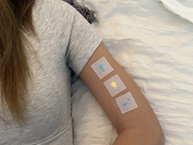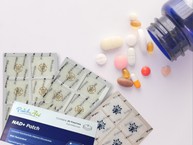Vitamin patches have recently soared in popularity, opening up questions on their effectiveness and legitimacy. Does the convenience offered by these easy-to-use patches sound too good to be true, or does it hold the promise of ditching traditionally inconvenient, large oral capsules? Let's discard the notion of these being mere "snake oil on a sticker" and dive into the reality of vitamin patches, specifically focusing on the PatchAid brand.
How Vitamin Patches Function
These patches work on scientific principles, with an adhesive layer containing the active ingredients, including vitamins, minerals, and herbal extracts. The patches are activated once adhered to the skin. The body heat triggers the adhesive layer, releasing the active ingredients. These are absorbed into the outer skin layer, the stratum corneum, and subsequently enter capillaries - the smallest blood vessels in our body. The nutrients then follow these capillaries into larger blood vessels, allowing circulation throughout your body to reach where they're needed.
Advantages over Oral Supplements
Oral supplements come in various forms, like pills, chewable tablets, gummies, lozenges, and liquids; however, they can't compete with the benefits offered by patches. Vitamin patches eliminate the worry of whether to be taken with or without food. Their absorption doesn't contend with the one happening in the stomach or gut, reducing inefficiencies due to competing nutrients.
Consuming large capsules could be challenging or uncomfortable for some, and many people loathe the taste of certain chewable tablets or liquids. None of these issues arise with vitamin patches since they are applied directly to the skin. They also cause fewer digestive side effects. Once again, since the active ingredients of patches bypass the stomach, no stomach-related side effects occur such as nausea, diarrhea, constipation, or stomach pain.
There's no offensive aftertaste, a notorious disadvantage associated with certain oral supplements. Furthermore, the matrix suspending the ingredients in vitamin patches allows them to contain a higher quantity and variety of active ingredients than many oral supplements.
A Little History on Transdermal Products
Medication delivery via patches isn't a novel concept. Widely accepted transdermal adhesive patches have been used for birth control, nitroglycerin for angina, pain relief patches, and nicotine patches for smokers. Other examples include medicated creams that deliver their ingredients via transdermal absorption like steroid creams, homeopathic, and skin care ointments.
The Scientific Backing of Vitamin Patches
Numerous studies have concluded that vitamin patches can effectively deliver their ingredients and help boost nutrient levels. Of course, individual variability in absorption should always be taken into account, thus consulting with a doctor to monitor your nutrient levels is recommended.
Assessing the Safety
The safety of any new product is a valid concern. It's comforting to learn that PatchAid Vitamin Patches are latex and gluten-free, a relief for those with allergies.
Gastric sleeve patients, who may struggle with oral supplements, have found these patches beneficial as "vitamins are within proper levels and no skin irritation" took place.
Although vitamin patches may seem too good to be true due to recent publicity, they are far from being mere snake oil on a sticker. With real ingredients and a scientifically supported delivery method, they can be easier to use than oral supplements. As always, it is best to consult your doctor to determine if vitamin patches could be a fitting choice for you to meet your health and nutrition needs.
FDA DISCLAIMER: The Food and Drug Administration has not evaluated these statements. PatchAid patches are not intended to diagnose, treat, cure or prevent any disease. Anyone with a medical condition should seek advice from a licensed medical practitioner. Individual results may vary.







